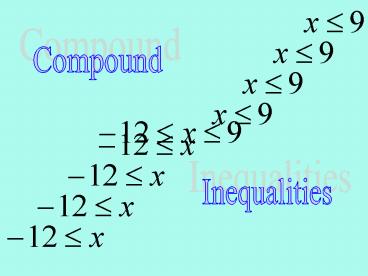Compound - PowerPoint PPT Presentation
Title:
Compound
Description:
Title: PowerPoint Presentation Author: Bob Greer Last modified by: Craig Cuddihy Created Date: 8/3/2002 5:18:53 PM Document presentation format: On-screen Show – PowerPoint PPT presentation
Number of Views:57
Avg rating:3.0/5.0
Title: Compound
1
Compound
Inequalities
2
You already know inequalities.
Often they are used to place
limits on variables.
That just means x can be any number equal to 9 or
less than 9.
3
Sometimes we put more than one limit on the
variable
Now x is still less than or equal to 9, but it
must also be
greater than or equal to 7.
4
Lets look at the graph
The upper limit is 9. Because x can be
equal to 9, we mark it with a filled-in
circle.
5
The lower limit is -7. We also need to mark it
with a filled-in circle.
6
There are other numbers that satisfy both
conditions.
Where are they found on the
graph?
What about 15?
It is less than or equal to 9?
Yes!
7
Where are they found on the
graph?
What about 15?
It is also greater than or
equal to -7?
No!
8
Because the word and is used, a number
on the graph needs to satisfy both parts of the
inequality.
9
So lets try 20. Does 20 satisfy both conditions?
Yes!
10
So lets try 20. Does 20 satisfy both conditions?
No!
11
Since 20 does not satisfy both
conditions, it cant belong to the
solution set.
12
There is one region we have not checked.
13
We need to choose a number from
that region.
You want to choose 0?
Good choice! 0 is usually the
easiest number to work with.
14
Does 0 satisfy both conditions?
Yes!
15
Does 0 satisfy both conditions?
Yes!
16
If one number in a region completely satisfies an
inequality,
you can know that every number in
that region satisfies the inequality.
17
Lets graph another inequality
18
First we mark the boundary points
The first sign
tells us we want an open circle,
19
and the 12 tells us where
the circle goes.
20
and the 12 tells us where
the circle goes.
21
The second sign
tells us we want a closed circle,
22
and the -1 tells us where the
circle goes.
23
The boundary points divide the line into
three regions
1
2
3
24
We need to test one point
from each region.
No!
Yes!
25
Notice that the word used is or,
instead of and.
No!
Yes!
26
Or means that a number
only needs to meet one condition.
No!
Yes!
27
Because 10 meets one condition,
the region to which it belongs . . .
. . . belongs to the graph.
Yes!
28
Lets check the next region
No!
No!
29
Because 1 meets neither condition,
the numbers in that region
will not satisfy the inequality.
30
Now the final region
Yes!
No!
31
Again, 15 meets one condition
so we need to shade that region.
Yes!
32
A quick review
To graph a compound inequality
1. Find and mark the boundary
points.
2. Test points from each region.
3. Shade the regions that satisfy
the inequality.
?
?
?
33
A quick review
1. Find and mark the boundary
points.
2. Test points from each region.
3. Shade the regions that satisfy
the inequality.
or
34
Given the graph below, write the
inequality.
First, write the boundary points.
35
Then look at the marks on the graph,
and write the correct symbol.
36
Since x is between the boundary points on
the graph,
it will be between the boundary points in
the inequality.
37
Since x is between the boundary points on
the graph,
it will be between the boundary points in
the inequality.
38
Try this one
Again, begin by writing the boundary points
39
And again, you need to choose the correct symbols
40
Because the x-values are not between the
boundary points on the graph,
we wont write x between the boundary points in
the equation.
41
Because the x-values are not between the
boundary points on the graph,
we wont write them between the boundary points
in the equation.
42
We will use the word, or, instead
Remember that or means a
number has to satisfy only one of the
conditions.
43
We will use the word, or, instead
Remember that or means a
number has to satisfy only one of the
conditions.
44
Is there any one number that belongs
to both shaded sections in the
graph?
NO!
Say NO!
45
So it would be incorrect to use and. And implies
that a number meets both conditions.
46
Solving compound inequalities is easy if . . .
. . . you remember that a compound inequality is
just two inequalities put together.
47
You can solve them both at the same time
48
Write the inequality from the graph
1 Write boundaries
2 Write signs
3 Write variable
49
Solve the inequality
Is this what you did?
50
You did remember to reverse the signs . . .
. . . didnt you?
Good job!































